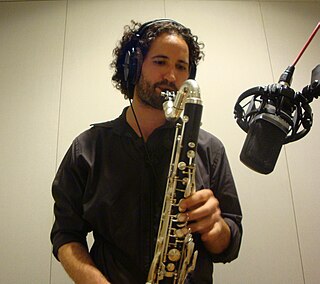An American in Paris is a jazz-influenced orchestral piece by American composer George Gershwin written in 1928. It was inspired by the time that Gershwin had spent in Paris and evokes the sights and energy of the French capital in the 1920s.

The clarinet is a musical-instrument family belonging to the group known as the woodwind instruments. It has a single-reed mouthpiece, a straight, cylindrical tube with an almost cylindrical bore, and a flared bell. A person who plays a clarinet is called a clarinetist.

The saxophone is a family of woodwind instruments. Saxophones are usually made of brass and played with a single-reed mouthpiece similar to that of the clarinet. When the player presses a key, a pad either covers a hole or lifts off a hole, lowering or raising the pitch, respectively.

Rhapsody in Blue is a 1924 musical composition by the American composer George Gershwin for solo piano and jazz band, which combines elements of classical music with jazz-influenced effects.
The music of Hawaii includes an array of traditional and popular styles, ranging from native Hawaiian folk music to modern rock and hip hop. Hawaii's musical contributions to the music of the United States are out of proportion to the state's small size. Styles like slack-key guitar are well-known worldwide, while Hawaiian-tinged music is a frequent part of Hollywood soundtracks. Hawaii also made a contribution to country music with the introduction of the steel guitar. In addition, the music which began to be played by Puerto Ricans in Hawaii in the early 1900s is called cachi cachi music, on the islands of Hawaii.
The Heart's Awakening is a song by Albert Ketèlbey, composed in 1907. It was published the same year by Novello.

The Clock and the Dresden Figures is a piece of light classical music for piano with orchestra by Albert Ketèlbey. It was composed, first performed and published in 1930.
In the Mystic Land of Egypt is a piece of light classical music for orchestra and optional voices composed by Albert Ketèlbey in 1931. The piece was published by Bosworth the same year, also in versions with piano.
In a Chinese Temple Garden is a piece of light classical music for orchestra by Albert Ketèlbey who composed it in 1923. Subtitled an Oriental Phantasy, it illustrates a priestly incantation, two lovers, a wedding procession, a street brawl and the restoration of calm by the beating of the temple gong. The piece was published by Bosworth in 1923, also in versions with piano and violin.

In a Persian Market is a piece of light classical music for orchestra with optional chorus by Albert Ketèlbey who composed it in 1920. Subtitled Intermezzo Scene, it was published by Bosworth in 1921. It evokes exotic images of camel-drivers, jugglers, and snake-charmers. When it was first published in a version for piano, it was advertised as an "educational novelty".
Robert Drasnin was an American composer and clarinet player.

Donald Henry Kay AM is an Australian classical composer.

In a Monastery Garden is a piece of light classical music by Albert Ketèlbey who composed it in 1915 after a visit to a real monastery garden. It was especially successful when performed by Ronnie Ronalde who often performed it as his finale and sold over a million recordings.
The Watermill is a piece of music which was written by Ronald Binge in 1958. The piece was also used in the British comedy film "Our Girl Friday" released in 1958, occasionally with Hawaiian guitar added, and later used as the theme music for a BBC television adaptation of The Secret Garden.

Bells Across the Meadows is a piece of light classical music by Albert Ketèlbey. It was published in 1921 for both orchestra and piano, and first recorded by the composer a year later. Ketèlbey called the piece a "characteristic intermezzo". In 2003 it was selected in the final poll by the BBC radio programme Your Hundred Best Tunes and voted the 36th most popular classical tune of all time.
Jesse Kaleihia Andre Kalima was born in Honolulu on October 31, 1920, at a time when the ukulele was just becoming recognized for its capability to be played as a solo instrument.
This is a summary of 1927 in music in the United Kingdom.

Jason Alder is an American-born clarinetist, bass clarinetist, and saxophonist. He is best known for his work in contemporary music, free improvisation, and electro-acoustic music.














